Multi-Annual Evaluation of Time Series of Sentinel-1 Interferometric Coherence as a Tool for Crop Monitoring
Abstract
1. Introduction
- Additional types of vegetation cover are considered, for a total of 18 different crop species.
- A multi-annual evaluation has been performed, which serves as a more complete validation for previous observations, as well as to reach broader conclusions.
- Other indices based in the coherence (e.g., the ratio of VV and VH coherence) have been tested.
- The performance of the time series covering only the growing season and considering the entire year has been compared.
2. Materials and Methods
2.1. Test Site and Reference Data
2.2. Satellite Data
2.3. Image Processing
2.4. Construction of the Time Series
2.5. Correlation between SAR and Optical Time Series
3. Results and Discussion
4. Conclusions
Author Contributions
Funding
Institutional Review Board Statement
Informed Consent Statement
Data Availability Statement
Acknowledgments
Conflicts of Interest
Abbreviations
| SAR | Synthetic aperture radar |
| VI | Vegetation Index |
| NDVI | Normalised Difference Vegetation Index |
| RVI | Radar Vegetation Index |
| DpRVI | Dual-pol Radar Vegetation Index |
| SNR | Signal-to-noise-ratio |
| S1 | Sentinel-1 |
| S2 | Sentinel-2 |
| ESA | European Space Agency |
References
- Steele-Dunne, S.; McNairn, H.; Monsivais-Huertero, A.; Judge, J.; Liu, P.W.; Papathanassiou, K. Radar Remote Sensing of Agricultural Canopies: A Review. IEEE J. Sel. Top. Appl. Earth Obs. Remote Sens. 2017, 10, 2249–2273. [Google Scholar] [CrossRef]
- Mandal, D.; Bhattacharya, A.; Rao, Y. Radar Remote Sensing for Crop Biophysical Parameter Estimation; Springer: Singapore, 2021. [Google Scholar] [CrossRef]
- Bannari, A.; Morin, D.; Bonn, F.; Huete, A. A review of vegetation indices. Remote Sens. Rev. 1995, 13, 95–120. [Google Scholar] [CrossRef]
- Rouse, J.; Haas, R.; Schell, J.; Deering, D.; Harlan, J. Monitoring the Vernal Advancement and Retrogradation (Green Wave Effect) of Natural Vegetation; Technical report, NASA/GSFCT Type III Final Report; NASA: Greenbelt, MD, USA, 1973.
- Blaes, X.; Defourny, P.; Wegmuller, U.; Della, V.; Guerriero, L.; Ferrazzoli, P. C-band polarimetric indexes for maize monitoring based on a validated radiative transfer model. Geosci. Remote Sens. IEEE Trans. 2006, 44, 791–800. [Google Scholar] [CrossRef]
- Veloso, A.; Mermoz, S.; Bouvet, A.; Toan, T.L.; Planells, M.; Dejoux, J.F.; Ceschia, E. Understanding the temporal behavior of crops using Sentinel-1 and Sentinel-2-like data for agricultural applications. Remote Sens. Environ. 2017, 199, 415–426. [Google Scholar] [CrossRef]
- Kim, Y.; Zyl, J. A Time-Series Approach to Estimate Soil Moisture Using Polarimetric Radar Data. Geosci. Remote Sens. IEEE Trans. 2009, 47, 2519–2527. [Google Scholar] [CrossRef]
- Mandal, D.; Kumar, V.; Ratha, D.; Dey, S.; Bhattacharya, A.; Lopez-Sanchez, J.; McNairn, H.; Rao, Y. Dual polarimetric radar vegetation index for crop growth monitoring using sentinel-1 SAR data. Remote Sens. Environ. 2020, 247, 111954. [Google Scholar] [CrossRef]
- Bamler, R.; Hartl, P. Synthetic Aperture Radar Interferometry. Inverse Probl. 1998, 14, R1. [Google Scholar] [CrossRef]
- Zebker, H.; Villasenor, J. Decorrelation in interferometric radar echoes. IEEE Trans. Geosci. Remote Sens. 1992, 30, 950–959. [Google Scholar] [CrossRef]
- Strozzi, T.; Dammert, P.; Wegmuller, U.; Martinez, J.M.; Askne, J.; Beaudoin, A.; Hallikainen, N. Landuse mapping with ERS SAR interferometry. IEEE Trans. Geosci. Remote Sens. 2000, 38, 766–775. [Google Scholar] [CrossRef]
- Engdahl, M.; Hyyppä, J. Land-cover classification using multitemporal ERS-1/2 InSAR data. IEEE Trans. Geosci. Remote Sens. 2003, 41, 1620–1628. [Google Scholar] [CrossRef]
- Sica, F.; Pulella, A.; Nannini, M.; Pinheiro, M.; Rizzoli, P. Repeat-pass SAR interferometry for land cover classification: A methodology using Sentinel-1 Short-Time-Series. Remote Sens. Environ. 2019, 232, 111277. [Google Scholar] [CrossRef]
- Jacob, A.W.; Vicente-Guijalba, F.; Lopez-Martinez, C.; Lopez-Sanchez, J.M.; Litzinger, M.; Kristen, H.; Mestre-Quereda, A.; Ziółkowski, D.; Lavalle, M.; Notarnicola, C.; et al. Sentinel-1 InSAR Coherence for Land Cover Mapping: A Comparison of Multiple Feature-Based Classifiers. IEEE J. Sel. Top. Appl. Earth Obs. Remote Sens. 2020, 13, 535–552. [Google Scholar] [CrossRef]
- Busquier, M.; Lopez-Sanchez, J.; Mestre-Quereda, A.; Navarro, E.; González-Dugo, M.; Mateos, L. Exploring TanDEM-X Interferometric Products for Crop-Type Mapping. Remote Sens. 2020, 12, 1774. [Google Scholar] [CrossRef]
- Mestre-Quereda, A.; Lopez-Sanchez, J.; Vicente-Guijalba, F.; Jacob, A.; Engdahl, M. Time-Series of Sentinel-1 Interferometric Coherence and Backscatter for Crop-Type Mapping. IEEE J. Sel. Top. Appl. Earth Obs. Remote Sens. 2020, 13, 4070–4084. [Google Scholar] [CrossRef]
- Nikaein, T.; Iannini, L.; Molijn, R.; Lopez-Dekker, P. On the Value of Sentinel-1 InSAR Coherence Time-Series for Vegetation Classification. Remote Sens. 2021, 13, 3300. [Google Scholar] [CrossRef]
- Amherdt, S.; Leo, N.; Pereira, A.; Cornero, C.; Pacino, M. Assessment of interferometric coherence contribution to corn and soybean mapping with Sentinel-1 data time series. Geocarto Int. 2022, 1–24. [Google Scholar] [CrossRef]
- Wegmuller, U.; Werner, C. Retrieval of vegetation parameters with SAR interferometry. IEEE Trans. Geosci. Remote Sens. 1997, 35, 18–24. [Google Scholar] [CrossRef]
- Blaes, X.; Defourny, P. Retrieving crop parameters based on tandem ERS 1/2 interferometric coherence images. Remote Sens. Environ. 2003, 88, 374–385. [Google Scholar] [CrossRef]
- Erten, E.; Lopez-Sanchez, J.; Yuzugullu, O.; Hajnsek, I. Retrieval of agricultural crop height from space: A comparison of SAR techniques. Remote Sens. Environ. 2016, 187, 130–144. [Google Scholar] [CrossRef]
- Romero-Puig, N.; Lopez-Sanchez, J. A Review of Crop Height Retrieval Using InSAR Strategies: Techniques and Challenges. IEEE J. Sel. Top. Appl. Earth Obs. Remote Sens. 2021, 14, 7911–7930. [Google Scholar] [CrossRef]
- Arslan, I.; Topakcı, M.; Demir, N. Monitoring Maize Growth and Calculating Plant Heights with Synthetic Aperture Radar (SAR) and Optical Satellite Images. Agriculture 2022, 12, 800. [Google Scholar] [CrossRef]
- Kavats, O.; Khramov, D.; Sergieieva, K.; Vasyliev, V. Monitoring of Sugarcane Harvest in Brazil Based on Optical and SAR Data. Remote Sens. 2020, 12, 4080. [Google Scholar] [CrossRef]
- Nasirzadehdizaji, R.; Cakir, Z.; Balik Sanli, F.; Abdikan, S.; Pepe, A.; Calò, F. Sentinel-1 interferometric coherence and backscattering analysis for crop monitoring. Comput. Electron. Agric. 2021, 185, 106118. [Google Scholar] [CrossRef]
- Pandit, A.; Sawant, S.; Mohite, J.; Pappula, S. Sentinel-1-derived coherence time-series for crop monitoring in Indian agriculture region. Geocarto Int. 2022, 1–21. [Google Scholar] [CrossRef]
- Villarroya-Carpio, A.; Lopez-Sanchez, J.; Engdahl, M. Sentinel-1 interferometric coherence as a vegetation index for agriculture. Remote Sens. Environ. 2022, 280, 113208. [Google Scholar] [CrossRef]
- Kumar, V.; Huber, M.; Rommen, B.; Steele-Dunne, S. Agricultural SandboxNL: A national-scale database of parcel-level processed Sentinel-1 SAR data. Sci. Data 2022, 9, 402. [Google Scholar] [CrossRef] [PubMed]
- Kellndorfer, J.; Cartus, O.; Lavalle, M.; Magnard, C.; Milillo, P.; Oveisgharan, S.; Osmanoglu, B.; Rosen, P.; Wegmuller, U. Global seasonal Sentinel-1 interferometric coherence and backscatter data set. Sci. Data 2022, 9, 73. [Google Scholar] [CrossRef]
- SIAR. Sistema de Información Agroclimática para el Regado. Gobierno de España. Ministerio de Agricultura, Pesca y Alimentación. 2022. Available online: https://eportal.mapa.gob.es/websiar/Inicio.aspx (accessed on 30 November 2022).
- Touzi, R.; Lopes, A.; Bruniquel, J.; Vachon, P. Coherence estimation for SAR imagery. IEEE Trans. Geosci. Remote Sens. 1999, 37, 135–149. [Google Scholar] [CrossRef]
- Vermunt, S.K.P.; Steele-Dunne, S.; Arntz, L.R.; Marinetti, C.; van der Valk, D.; Iannini, L.; Molijn, R.; Westerdijk, K.; van der Sande, C. Crop Monitoring Using Sentinel-1 Data: A Case Study from The Netherlands. Remote Sens. 2019, 11, 1887. [Google Scholar] [CrossRef]
- Palmisano, D.; Mattia, F.; Balenzano, A.; Satalino, G.; Pierdicca, N.; Guarnieri, A. Sentinel-1 Sensitivity to Soil Moisture at High Incidence Angle and the Impact on Retrieval Over Seasonal Crops. IEEE Trans. Geosci. Remote Sens. 2021, 59, 7308–7321. [Google Scholar] [CrossRef]
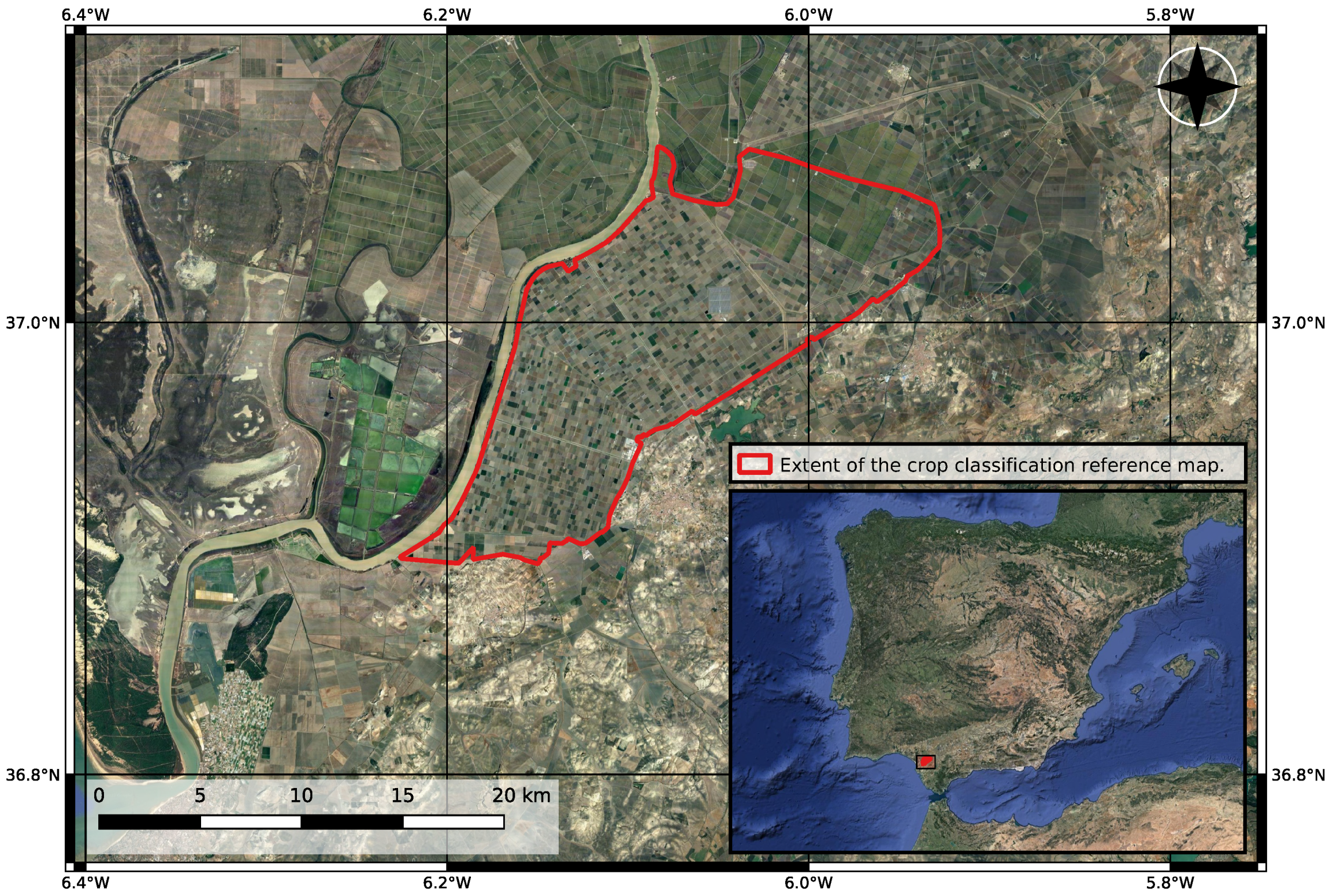
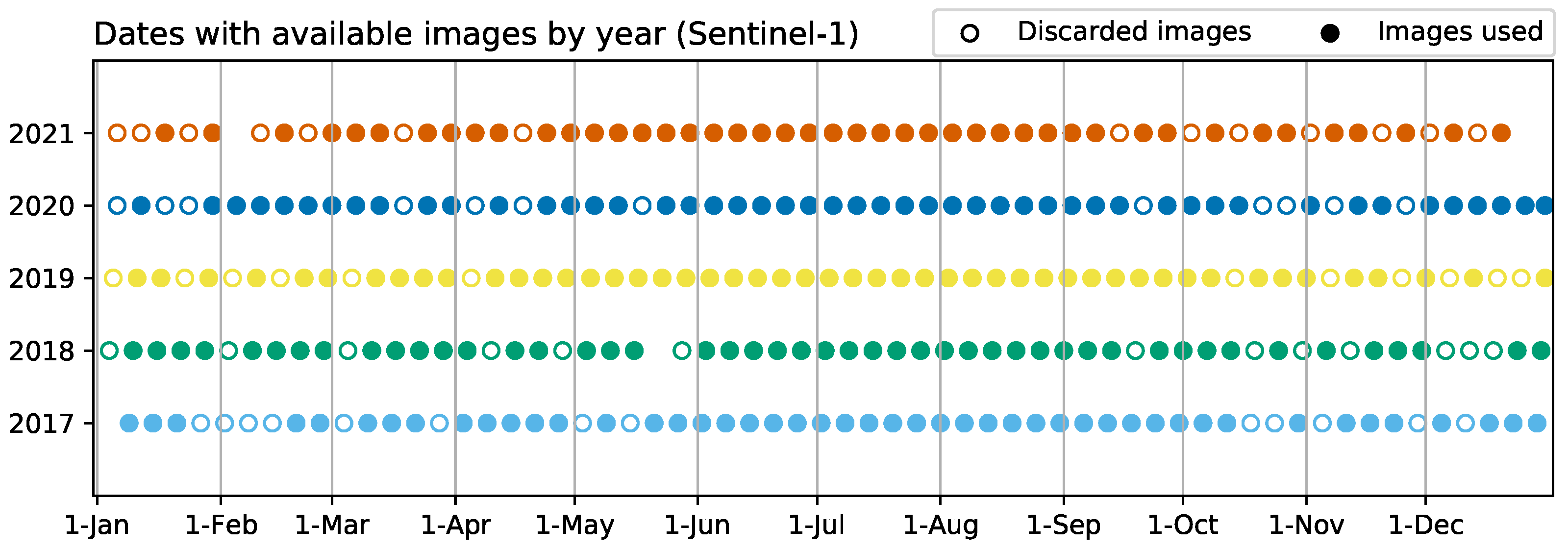
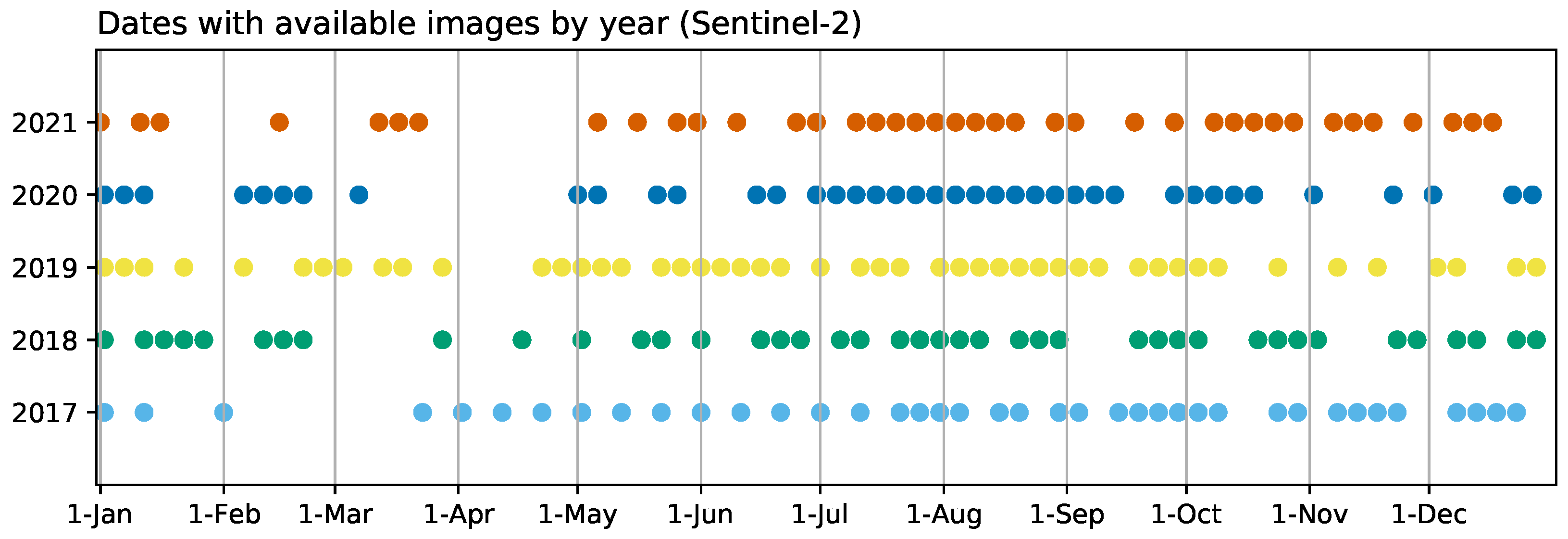
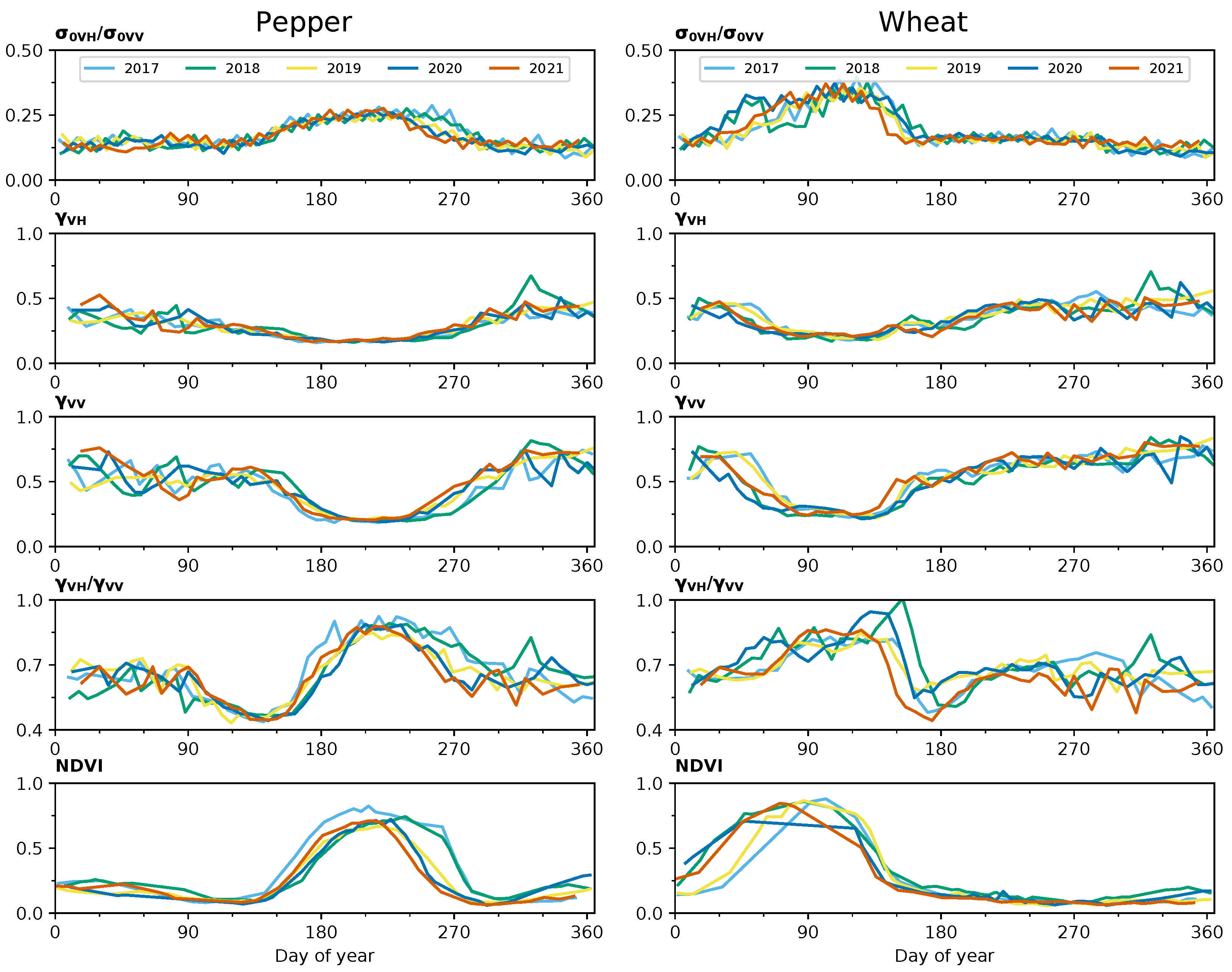
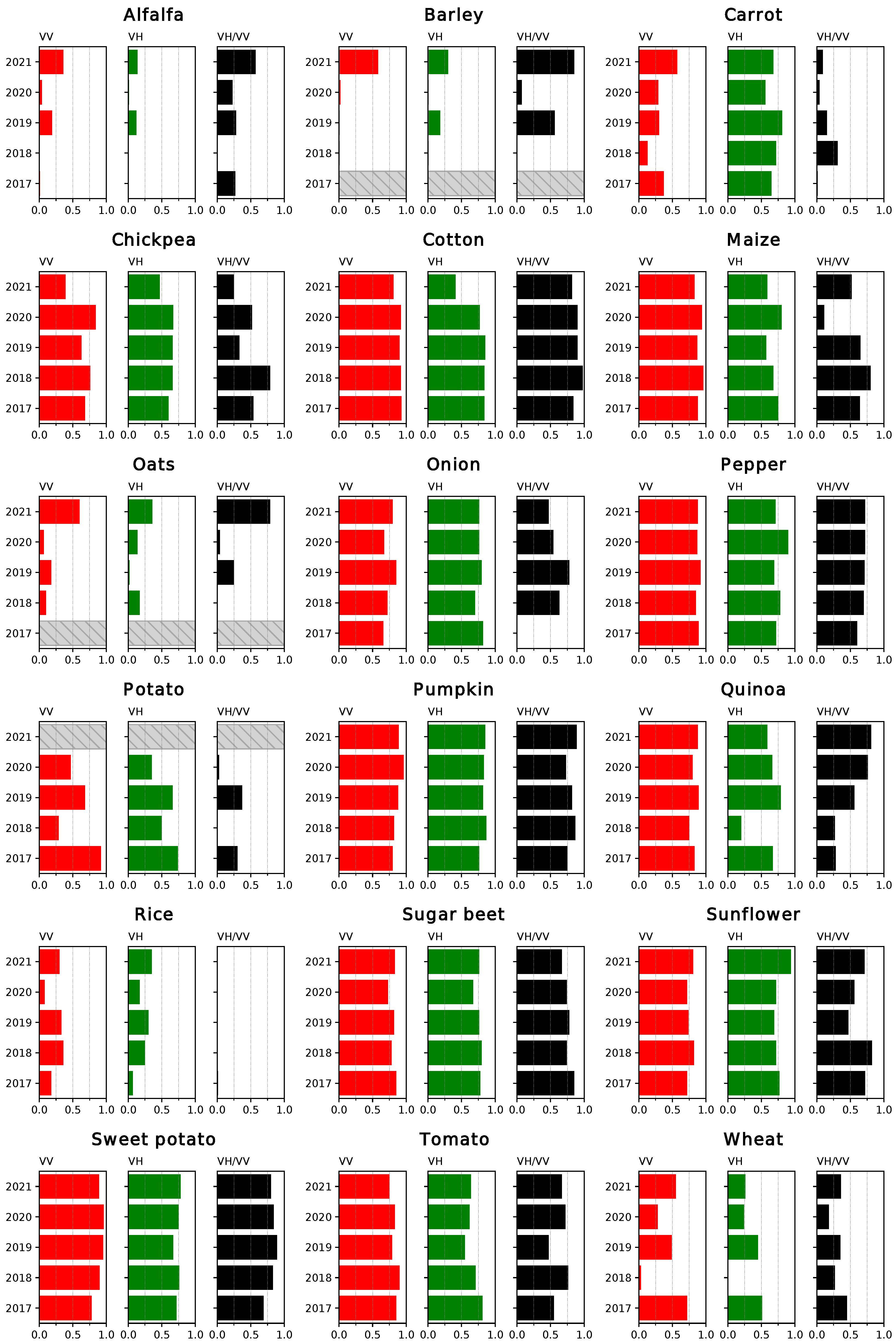
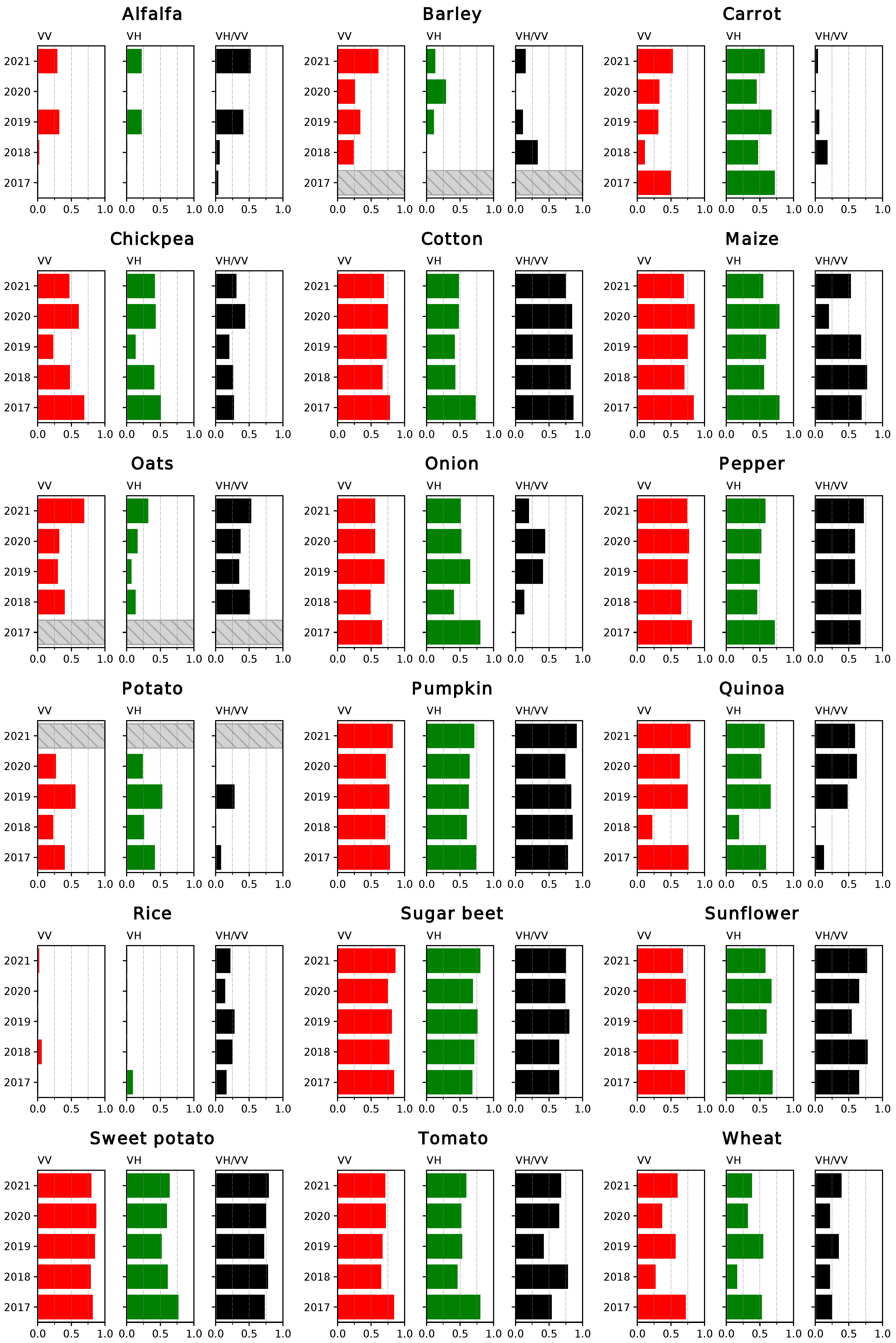


| Crop Type | 2017 | 2018 | 2019 | 2020 | 2021 |
|---|---|---|---|---|---|
| Alfalfa | 4.10 | 3.26 | 2.14 | 2.42 | 3.05 |
| Barley | - | 1.81 | 1.05 | 0.73 | 1.06 |
| Carrot | 2.22 | 0.94 | 1.06 | 1.82 | 2.24 |
| Chickpea | 0.55 | 1.02 | 0.48 | 1.11 | 0.61 |
| Cotton | 60.47 | 82.10 | 78.16 | 77.69 | 80.54 |
| Fallow | 1.17 | 4.68 | 3.36 | 4.39 | 19.82 |
| Maize | 6.73 | 5.59 | 10.81 | 4.00 | 4.07 |
| Oats | - | 1.69 | 1.29 | 0.87 | 0.18 |
| Onion | 1.58 | 2.25 | 3.66 | 6.22 | 5.36 |
| Pepper | 0.67 | 3.59 | 4.16 | 4.68 | 3.80 |
| Potato | 0.43 | 0.50 | 0.37 | 0.88 | - |
| Pumpkin | 0.96 | 1.18 | 1.17 | 1.01 | 0.87 |
| Quinoa | 1.08 | 0.74 | 1.53 | 2.31 | 2.63 |
| Rice | 27.81 | 29.62 | 30.35 | 31.19 | 17.46 |
| Sugar beet | 21.23 | 19.48 | 14.42 | 14.81 | 12.87 |
| Sunflower | 6.31 | 4.79 | 3.16 | 4.13 | 4.32 |
| Sweet potato | 1.27 | 2.04 | 3.14 | 2.38 | 0.56 |
| Tomato | 32.46 | 27.96 | 35.45 | 32.88 | 34.76 |
| Wheat | 4.38 | 4.87 | 3.29 | 4.49 | 2.80 |
| TOTAL | 173.43 | 198.11 | 199.05 | 198.02 | 196.99 |
Disclaimer/Publisher’s Note: The statements, opinions and data contained in all publications are solely those of the individual author(s) and contributor(s) and not of MDPI and/or the editor(s). MDPI and/or the editor(s) disclaim responsibility for any injury to people or property resulting from any ideas, methods, instructions or products referred to in the content. |
© 2023 by the authors. Licensee MDPI, Basel, Switzerland. This article is an open access article distributed under the terms and conditions of the Creative Commons Attribution (CC BY) license (https://creativecommons.org/licenses/by/4.0/).
Share and Cite
Villarroya-Carpio, A.; Lopez-Sanchez, J.M. Multi-Annual Evaluation of Time Series of Sentinel-1 Interferometric Coherence as a Tool for Crop Monitoring. Sensors 2023, 23, 1833. https://doi.org/10.3390/s23041833
Villarroya-Carpio A, Lopez-Sanchez JM. Multi-Annual Evaluation of Time Series of Sentinel-1 Interferometric Coherence as a Tool for Crop Monitoring. Sensors. 2023; 23(4):1833. https://doi.org/10.3390/s23041833
Chicago/Turabian StyleVillarroya-Carpio, Arturo, and Juan M. Lopez-Sanchez. 2023. "Multi-Annual Evaluation of Time Series of Sentinel-1 Interferometric Coherence as a Tool for Crop Monitoring" Sensors 23, no. 4: 1833. https://doi.org/10.3390/s23041833
APA StyleVillarroya-Carpio, A., & Lopez-Sanchez, J. M. (2023). Multi-Annual Evaluation of Time Series of Sentinel-1 Interferometric Coherence as a Tool for Crop Monitoring. Sensors, 23(4), 1833. https://doi.org/10.3390/s23041833





